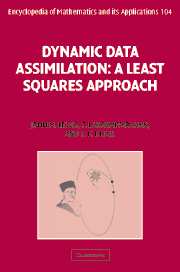Book contents
- Frontmatter
- Contents
- Preface
- Acknowledgements
- PART 1 GENESIS OF DATA ASSIMILATION
- PART II DATA ASSIMILATION: DETERMINISTIC/STATIC MODELS
- PART III COMPUTATIONAL TECHNIQUES
- PART IV STATISTICAL ESTIMATION
- PART V DATA ASSIMILATION: STOCHASTIC/STATIC MODELS
- PART VI DATA ASSIMILATION: DETERMINISTIC/DYNAMIC MODELS
- PART VII DATA ASSIMILATION: STOCHASTIC/DYNAMIC MODELS
- PART VIII PREDICTABILITY
- Epilogue
- References
- Index
Preface
Published online by Cambridge University Press: 18 December 2009
- Frontmatter
- Contents
- Preface
- Acknowledgements
- PART 1 GENESIS OF DATA ASSIMILATION
- PART II DATA ASSIMILATION: DETERMINISTIC/STATIC MODELS
- PART III COMPUTATIONAL TECHNIQUES
- PART IV STATISTICAL ESTIMATION
- PART V DATA ASSIMILATION: STOCHASTIC/STATIC MODELS
- PART VI DATA ASSIMILATION: DETERMINISTIC/DYNAMIC MODELS
- PART VII DATA ASSIMILATION: STOCHASTIC/DYNAMIC MODELS
- PART VIII PREDICTABILITY
- Epilogue
- References
- Index
Summary
What is dynamic data assimilation?
‘Assimilate’ is a word that conjures up a variety of meanings ranging from its use in the biological to the social to the physical sciences. In all of its uses and meanings, the word embraces the concept of incorporation. “Incorporation of what?” is central to the definition. In our case, we expand its usage by appending the words dynamic and data – where dynamic implies the use of a law or equation or set of equations, typically physical laws. Now we have dynamic law, we have data and we assimilate. It is this melding of data to law or matching of data and law or, in the spirit of the dictionary definition, incorporating data into the law that captures the meaning of our title, dynamic data assimilation.
Its modern-day usage stems from the efforts of meteorologists to estimate the 3-D state of the global atmosphere. The genesis of this effort began in the midto late-1960s when atmospheric general circulation models (now known as global or climate prediction models) came into prominence and the weather satellites began to collect data on a global scale. The major question surfaced: Is it possible or feasible to make long-term weather predictions, predictions on the order of weeks instead of days? Certainly a first step in such an endeavor is to estimate the atmospheric state in the global domain so that the deterministic model can use this state as initial condition and march out into the future via numerical integration of the governing equations. Over the populated continents of the world, Europe and the North American Continent, conventional data are generally sufficient to define a meaningful state.
- Type
- Chapter
- Information
- Dynamic Data AssimilationA Least Squares Approach, pp. xiii - xxPublisher: Cambridge University PressPrint publication year: 2006

